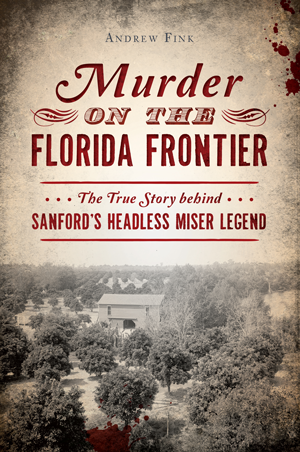
Beware the Headless Miser of Sanford, Florida: Sam McMillan
Florida, late 1800s, right in the middle of Reconstruction. Imagine yourself arriving at the station in your new town, gazing out at the miles of citrus groves, seeing farm workers and field hands handling the fresh, juicy crop. It’s harvest season, and the crates are filling up. Oranges, grapefruit, papayas, you name it: from the windows of your train, all you can see is green, green gold. Such were the conditions in 1882 when Sam McMillan, a native of Ohio who had resettled to Sanford, Florida, met his untimely end. McMillan, a careful spender by some accounts, but a genuine, old-school miser by others — he distrusted banks, and carried thousands of dollars in a fat wallet tied with twine — had been preparing to leave Sanford for some time, trying to sell his citrus grove and turn his back to central Florida.

But he never made the trip: on September 30, 1882, he was seen walking towards the property of his neighbor Archie Newton, an Englishman and prospective buyer of McMillan’s parcel who had arrived in Sanford through family business connections. As author Andrew Fink says in his book Murder on the Florida Frontier: The True Story behind Sanford’s Headless Miser Legend, “It was the last time anyone saw Sam McMillan alive.”
On October 17, McMillan’s body was found submerged and partially dismembered in nearby Crystal Lake. The corpse had been tied down with a rope and weighted with a burlap sack filled with an iron pot full of nails. After nearly three weeks in the water, McMillan was in terrible shape: decomposed, decaying, chewed on by all manner of creatures, most of the organs had been devoured, both hands were missing, and most of the appendages hung only by tendons. And to top it off, the body was missing its head.
Based on a growing amount of evidence, Newton was quickly arrested on suspicion of murder. Because the head was vital to the inquest, the constable ordered another search: a few days later, another sweep of the lake was conducted near the original site and sure enough, there lay McMillan’s unfortunate skull, about twenty-five feet away. Denuded of skin, jaw detached, flesh pooling on the lake floor, it’s hard to imagine anyone recognizing poor Sam McMillan.

Nevertheless, his remains constituted key evidence, so much that Fink records the searchers actually took the first train back to the preliminary hearing, and plonked the sack with the severed head down on the table for everyone in the room to see. According to later testimony, the medical examiner Dr. F.A. Caldwell was called into inspect the specimen. Caldwell discovered a ragged hole near the base of the skull, consistent with trauma from a blunt object or a gunshot—and after puncturing the lining of the brain, which was softened and decomposed, gave it a good shake. Witnesses present heard something rattling around inside, and sure enough, out dropped a bullet, right there in front of everyone. It wasn’t the smoking gun, but it might have been the next best thing.
It’s hard to imagine any medical examiner acting so brash today, but standards differed in the late nineteenth century (or maybe just in Florida—one does wonder). Later testimony revealed that there was no way to prove that McMillan’s decapitation was part of his death—that there would have been no reason to separate his head from his body, that a gunshot alone would not have sufficed to do the deed, and that there were any number of willing alligators or snapping turtles ready to snack on a fleshy neck in the lake. But more evidence against Newton mounted, from testimony regarding his alleged movements that weekend to character witnesses attacking his morals to articles of Sam McMillan’s found at the Newton homestead, and the Englishman was ultimately convicted of the crime.
An appeal to the Florida Supreme Court, and two more years of investigation and legal wrangling, ultimately resulted in Newton’s acquittal: the vast majority of the evidence against him was circumstantial, the Court found, and key testimony was found as either inadmissible or improper. Most importantly, there was simply no direct evidence tying Newton to the crime. Understandably, not long after the verdict was overturned, Newton and his wife fled Sanford, Florida, never to return—sadly, the same could not be true of McMillan.
For as Fink records, history doesn’t tell us exactly where the Sanford authorities buried the body of Samuel McMillan, where they buried his head, or whether his head was even buried at all. Fink suggests that it may have even been kept as a souvenir by one of the local officials. Ghost stories began to pop up soon afterward, with visitors to the McMillan parcel seeing a horribly decomposed body chasing after a floating head, never quite seeming to catch it. “That means,” Fink writes, “the ghost is still restless.”
So next time you visit central Florida, in the area known as the Mystic Circle, keep a sharp eye outside the window of your carriage. While some of the citrus groves may have given way to subdivisions, you never know just who you might see, still out there, searching after what he misses most.




